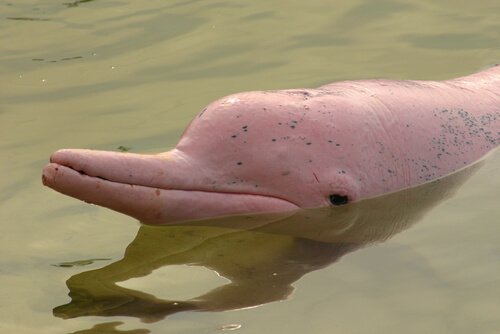The Amazon Pink River Dolphin: A Fascinating Creature

The Amazon pink river dolphin is a beautiful and fascinating creature that has inspired endless myths and legends. It’s one of the few animals in the cetacea family that lives in rivers, and its color is definitely the thing that stands out the most. In today’s article, you can learn about this amazing animal.
Traits of the Amazon Pink River Dolphin
Also known as the “boto” and “bufeo,” the Amazon Pink River Dolphin is an 8-foot long, 400-pound (in males) cetacean. There’s a major difference in the physical traits between males and females: females can be 50% shorter and lighter than males.
Their most striking feature is the pink color of their skin, which can have a variety of different tones. They’re grey when they’re born and throughout their youth, but they change in color as they mature. On top of that, males are often pinker than females. However, this all depends on the transparency, temperature, and location of the waters they live in.
The Amazon pink river dolphin has a long snout with sharp teeth to hunt prey. It emerges to the surface every once and a while to breathe. When it does, it shoots out a nearly 6-foot jet stream of water through its blowhole.

Its habitat and diet
This species lives in the freshwaters of South America such as the Tapajós, Madeira, and Xingú rivers. It’s also one of the most common inhabitants of the Orinoco River.
They prefer small streams and rivers. Depending on the time of year, they might even make their way into the flooded forests or plains during the rainy season.
Males go through the main river bodies when the water levels are high. However, females and their offspring stay in the flooded areas because the water is calm, which makes it easy for them to rest, lactate, and find food.
Their diet consists of a wide variety of animals like piranhas and sea bass. Their short teeth and the shape of their snout prevent them from capturing turtles or lobsters. They hunt early in the morning and in the afternoon because that’s when schools of fish pass by them and are easy prey.

Reproduction and habits
The Amazon Pink River Dolphins are very solitary animals, but when they do form groups, they won’t “accept” more than 4 dolphins. You’ll most likely see mother dolphins with their young. During the rainy season, they migrate and are able to live in the same body of water without having any conflicts by the time it’s over.
The Amazon Pink River Dolphin is less sociable and playful than its ocean-dwelling cousins, and is very afraid of unfamiliar things, like human beings. They swim slowly, are hard to train, and have a high mortality rate in captivity.
Females reach sexual maturity when they’re six years old, and males take a few more years to develop. Their mating period is during the dry season, and they have 11-month pregnancies. Babies stay with their mothers for one year, and these females become fertile again two years after giving birth.
The legend of the Pink Dolphin
Many different cultures in the Amazons have myths about these dolphins. One says that there’s actually the spirit of a drowned human trapped inside them.
Another says that on full moon nights, they turn into human men and seduce women to reproduce. They tell young girls to be careful if they see a man dressed in white because it could be one of these dolphins.
The Amazon pink river dolphin is a beautiful and fascinating creature that has inspired endless myths and legends. It’s one of the few animals in the cetacea family that lives in rivers, and its color is definitely the thing that stands out the most. In today’s article, you can learn about this amazing animal.
Traits of the Amazon Pink River Dolphin
Also known as the “boto” and “bufeo,” the Amazon Pink River Dolphin is an 8-foot long, 400-pound (in males) cetacean. There’s a major difference in the physical traits between males and females: females can be 50% shorter and lighter than males.
Their most striking feature is the pink color of their skin, which can have a variety of different tones. They’re grey when they’re born and throughout their youth, but they change in color as they mature. On top of that, males are often pinker than females. However, this all depends on the transparency, temperature, and location of the waters they live in.
The Amazon pink river dolphin has a long snout with sharp teeth to hunt prey. It emerges to the surface every once and a while to breathe. When it does, it shoots out a nearly 6-foot jet stream of water through its blowhole.

Its habitat and diet
This species lives in the freshwaters of South America such as the Tapajós, Madeira, and Xingú rivers. It’s also one of the most common inhabitants of the Orinoco River.
They prefer small streams and rivers. Depending on the time of year, they might even make their way into the flooded forests or plains during the rainy season.
Males go through the main river bodies when the water levels are high. However, females and their offspring stay in the flooded areas because the water is calm, which makes it easy for them to rest, lactate, and find food.
Their diet consists of a wide variety of animals like piranhas and sea bass. Their short teeth and the shape of their snout prevent them from capturing turtles or lobsters. They hunt early in the morning and in the afternoon because that’s when schools of fish pass by them and are easy prey.

Reproduction and habits
The Amazon Pink River Dolphins are very solitary animals, but when they do form groups, they won’t “accept” more than 4 dolphins. You’ll most likely see mother dolphins with their young. During the rainy season, they migrate and are able to live in the same body of water without having any conflicts by the time it’s over.
The Amazon Pink River Dolphin is less sociable and playful than its ocean-dwelling cousins, and is very afraid of unfamiliar things, like human beings. They swim slowly, are hard to train, and have a high mortality rate in captivity.
Females reach sexual maturity when they’re six years old, and males take a few more years to develop. Their mating period is during the dry season, and they have 11-month pregnancies. Babies stay with their mothers for one year, and these females become fertile again two years after giving birth.
The legend of the Pink Dolphin
Many different cultures in the Amazons have myths about these dolphins. One says that there’s actually the spirit of a drowned human trapped inside them.
Another says that on full moon nights, they turn into human men and seduce women to reproduce. They tell young girls to be careful if they see a man dressed in white because it could be one of these dolphins.
This text is provided for informational purposes only and does not replace consultation with a professional. If in doubt, consult your specialist.








